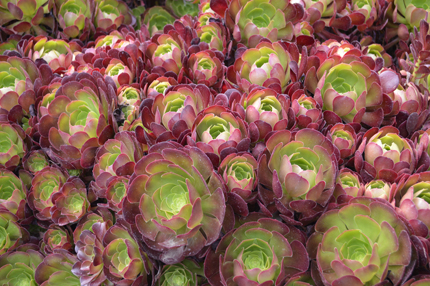by Matt Corrion
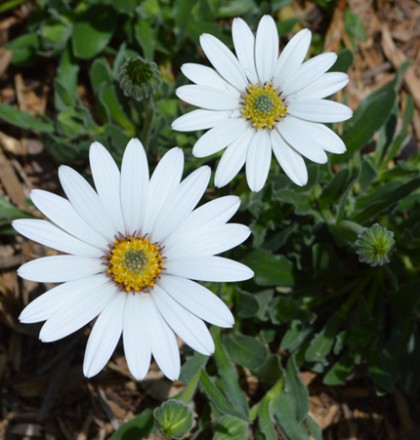
Osteospermum ‘Avalanche’ flowers
Looking for a low-growing, flowering perennial that will impress your friends and neighbors when they visit your garden? Look no further than the vigorous mat-forming daisy, ‘Avalanche’ White Sun Daisy. This cultivar, named to the Plant Select program in 2011, is related to other sun daisies, whose genus is originally native to South Africa. A shimmering riot of white, daisy-like composite flowers are produced above a mat of oblong, nearly succulent dark evergreen leaves. This variety of sun daisy is more disease resistant, blooms more heavily, and is more cold hardy than other Osteospermum cultivars. The numerous blooms close at night, showing off their metallic undersides of the petals.
Consider reserving a spot for this ‘Avalanche’ in your xeriscape or in the front of your sunny perennial planting beds.
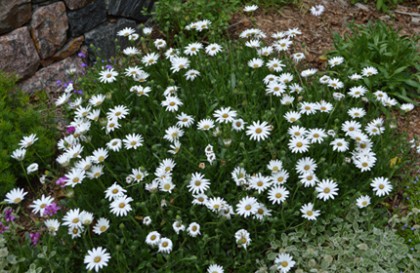
Osteospermum ‘Avalanche’
PLANT STATS
Scientific Name: Osteospermum ‘Avalanche’
Plant Type: Perennial Groundcover
Mature Height: 8″-12″
Mature Spread: 24″-42″
Cold Hardiness Zone: USDA zones 4 – 9 (up to 8,000 ft)
Water Requirement: Low to medium water needs. Seems to do equally well in dry conditions or with supplemental irrigation.
Exposure: Full Sun to light shade. I have experimented with it in my garden in afternoon shade, and it seems to do quite well.
Soil: Adaptable. I have planted it in some pretty heavy, poor clay soil and it seems to thrive there unlike many other Xeric perennials.
Flower Color & Bloom Time: Flowers are white with yellow-green centers, exhibiting a unique metallic tinge on the undersides of the petals. Blooms appear in early to mid-summer and continue in fall through the first frost. Sometimes flowering will slow down in late summer or in really hot, dry weather.
Winter Interest: Minimal.
Disadvantages: I have not found any to date. Some literature mentions that Osteospermum plants are susceptible to fungal pathogens.
Availability and Sizes: This plant seems to be regularly available at retail nurseries around the front range. It is typically sold in 1 gallon or 4″ pots.
Best Features: The flowers are beautiful, but to me what really sets this plant apart is the mass of dark green foliage. In the right conditions it develops a wide mat of dark green foliage that acts a groundcover, spreading up to 42″ wide.
Maintenance Tip: While drought tolerant, Avalanche White Sun Daisy will produce the best flowers and mat of foliage if it is watered once or twice per week during dry periods.
This is the official blog of Outdoor Design Group, Colorado Landscape Architects. For more information about our business and our services, click here.
Related Posts:
by Todd Rutherford
You may have heard recent dire reports about the health of bees and butterflies. Whether it’s the declining number of the amazing Monarch Butterfly or the constant reports of “colony collapse disorder” in beehives, these reports are alarming. One of the best and easiest things you can do to help these crucial creatures survive and thrive is to plant the perennials, shrubs and trees in your landscape that will give bees and butterflies the food they depend on. Help these pollinators while creating an inviting outdoor space for yourself. Or, if you are pondering the possibility of updating your landscaping in the near future, let Outdoor Design Group design a bee and butterfly friendly garden for you.
Below are listed several different perennials, shrubs and trees that provide food for bees, butterflies and other pollinators. While I’ve listed several pollinator friendly plants here, there are still many more to choose from. Consult the Xerces Society, a nonprofit organization that protects wildlife through the conservation of invertebrates and their habitat, or your local university extension agent for more suggestions of pollinator friendly plants that will grow well in your area.
Perennials for Butterflies and Bees
Asclepias species. Commonly referred to as the Milkweeds due to their milky sap, there are many species in the Asclepias genus that are utilized by butterflies and bees. Many biologists believe that the decline in the Monarch butterfly population is directly correlated to the increasing use of herbicides used to kill Milkweeds in North America, because Monarch butterflies depend on Milkweeds as food for their larvae. There are many Asclepias species that grow in North America, but two that do well in Colorado are Asclepias tuberosa (showy milkweed) and Asclepias speciosa (butterfly weed). Ht. and Wd. varies depending on species and cultivar, generally 15-60” Ht. x 12-18” Wd.
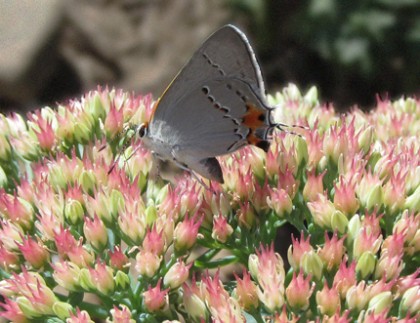
The Mint Family (Lamiaceae). Many familiar and popular garden plants from the so-called Mint Family are favored by bees. Some of these are culinary sage, Russian sage, mint, basil, rosemary, oregano, thyme, lavender, lamb’s ear, hyssop, lemon balm, and bee balm. Ht. and Wd. varies depending on species and cultivar.
Sedum ‘Autumn Joy’. This tall stone crop flowers in mid to late summer (see photo above), making it a good late-season nectar source for pollinators when many other plants have stopped flowering. 18-24” Ht. x 12-18” Wd.
Datura wrightii Although Sacred Datura may not always be a perennial in all parts of Colorado, depending on the severity of the winter, bees love it’s flowers which emit an amazing scent, so even if it is frost tender and may need to be regrown from seed in colder areas, it is worth it. The bees will thank you. 18-24” Ht. x 6-8’ Wd.
Shrubs for Butterflies and Bees
Buddleia alternifolia ‘Argentea’, Silver Fountain Butterfly Bush. This butterfly bush blooms earlier than the other species and cultivars of Buddleia. This large shrub does well in most soils and sites but doesn’t like its roots to stay wet. 12-15’ Ht. x 10-12’ Wd.
Caryopteris x clandonensis ‘Blue Mist’. Blue Mist Spirea is also in the Mint Family, and is not a true spirea, but has flowers that resemble those of the spirea. It is a hybrid of C. incana x C. mongolica that was created in the 1930’s in England by Arthur Simmonds. There are several cultivars of Caryopteris x clandonensis that are good choices for Colorado and which bees and butterflies (see photo below) love. 3-4’ Ht. x 2-3’ Wd.
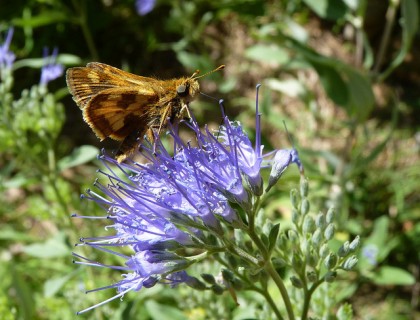
Mahonia. This genus has several members whose flowers will delight your winged friends. Mahonia aquifolium is a familiar shrub known as Oregon Grape Holly. It is evergreen, easy to grow and produces edible (but not tasty) berries from the yellow flowers that bees appreciate. 4-6’ Ht. x 4-6’ Wd.
Prunus bessyi, Sand Cherry 4-6’ Ht. x 4-6’ Wd.
Philadelphus lewisii, Cheyenne Mock Orange 5-7’ Ht. x 4-6’ Wd.
Rhus aromatica ssp. Trilobata, Three leaf sumac 3-6’ Ht. x 3-6’ Wd.
Rosa woodsii, Wood’s Rose 3-6’ Ht. x 3-6’ Wd.
Trees for Butterflies and Bees
Tilia cordata, Little Leaf Linden. Linden trees perfume the air in springtime and offer up small yellow flowers (see photo below) for pollinators. I’ve heard that in Eastern Europe, a type of beer is flavored with the linden flowers. 30-50’ Ht. x 25-35’ Wd. (depends on cultivar).
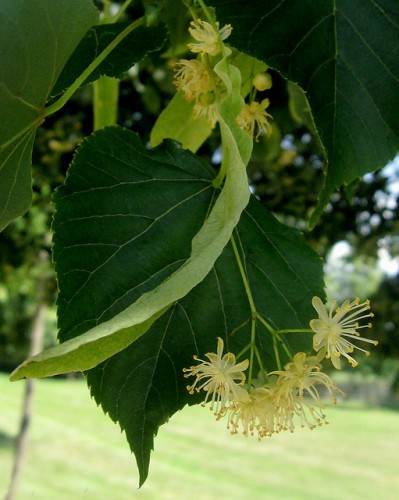
Apple / Crabapples. The Malus genus offers many species and cultivars that are attractive to bees. In fact, if there were no bees, you probably would not get any fruit from your apple trees. Ht. and Wd. varies depending on cultivar.
Prunus armeniaca ‘Moongold’, Moongold Apricot. 15-25’ Ht. x 15-25’ Wd.
Prunus nigra ‘Princess Kay’, Princess Kay Plum 15-20’ Ht. x 10-15’ Wd.
Catalpa speciosa, Western Catalpa 40-60’ Ht. x 30-50’ Wd.
Cercis Canadensis, Eastern Redbud 20-30’ Ht. x 20-30’ Wd.
Crataegus ambigua, Russian Hawthorne 15-25’ Ht. x 20’ Wd.
This is the official blog of Outdoor Design Group, Colorado Landscape Architects. For more information about our business and our services, click here.
Related Posts:
by Matt Corrion
1) Ditch the bluegrass turf lawn, completely or partially. Bluegrass turf uses far more water than alternative landscaping choices.
2) Set your mower on its highest setting so turf grass is not cut too short. Longer grass keeps the soil cooler and reduces evaporation.
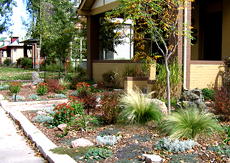
Consider redesigning your landscape so it requires less water and looks more interesting
3) Use the mulch setting on your lawn mower so grass clippings stay on the lawn, which helps slow evapotranspiration and provides nutrients to the soil.
4) Do not install bluegrass turf on slopes, especially south facing slopes, because much of the water will run off the slope and sprinklers will need to run for longer times to compensate. Instead consider planting shrubs or native plants with drip irrigation on a slope.
5) Mulch your trees, shrubs and perennials to reduce water use. Mulch slows down the evaporation of soil moisture, reduces water run-off, and reduces weeds which can steal moisture from your plants.
6) Consider replacing your existing high-water turf lawn with low-water turf options such as buffalo grass, blue grama grass or a fescue grass.
7) Plant native plants that are more appropriate for the climate you live in.
8) If you plant non-native plants, use ones that are adapted to your climate conditions, such as iceplant from South Africa, and Russian sage from Central Asia.
9) Place your plants in groups organized by water use, so as to avoid overwatering low water need plants.
10) Plant trees in your turf lawn to provide shade for the lawn and reduce evapotranspiration of the grass.
11) Follow your water provider’s summer watering rules, and any watering restrictions that may be in place at that time.
12) Don’t water during the hottest time of the day. It is best to water between 6 pm and 10 am. Watering during the hottest time of the day increases the evaporation of the water before it reaches the roots of your plants.
13) Don’t water when it is windy. Just as watering during the hottest time of day increases water loss due to increased evaporation, so does watering when it is windy.
14) When shoveling snow in winter, place snow piles where it will melt and water trees and shrubs that can benefit from extra moisture in winter.
15) Install a rain sensor to avoid having your irrigation system run when it is raining, or the day after a heavy rainfall event.
16) If you don’t have an automatic irrigation system, use a mechanical or digital timer with your sprinklers.
17) If you have an automatic irrigation system, check it once a month or more often to fix any leaks or problems that may occur.
18) Use drip irrigation to water your landscape plants. Drip irrigation is the most efficient form of irrigation because the water is not sprayed into the air which increases evaporation of the water before it reaches the plants.
19) Avoid placing sprinkler heads against fences and hardscape. Instead, install a strip of rock mulch between fences / hardscape and sprinkler heads. In addition to reducing water waste, this minimizes water damage and the need for turf edge trimming.
20) Improve your soils water holding capacity by amending the soil with organic matter.
21) Make your landscape more permeable to keep storm water on your property. Instead of a solid concrete patio, install a unit paver patio to allow water to percolate down rather than running off.
22) Divide watering times into shorter shifts to improve water absorption, and avoid runoff. This is sometimes referred to as the “cycle and soak” method.
23) Direct gutter downspouts to planted areas rather than streets or storm water areas.
24) Save rainwater from your roof for irrigating plants.
25) Save indoor “grey” water for irrigating trees and shrubs.
26) If local codes allow, hire a plumber (or DIY) to pipe your grey water to your landscaping.
27) Use a mild/natural dish soap for washing dishes to keep this grey water safer for your landscape plants.
28) Bathe your pets outside over turf areas that need water, using mild/natural soap.
29) Wash fruits and vegetables outside over your lawn to allow wash water to irrigate the turf.
30) Plant trees (adapted for your climate) to shade your turf area to reduce evapo-transpiration of the turf.
31) Consult a landscape architect or horticulturalist to learn the best plants to use in your climate and growing zone.
32) Before planting certain species of plants, do extensive soil preparations. Some plants benefit from additional organic matter, while others will perform better if drainage is improved.
33) Save fallen leaves in autumn and use as a mulch around trees, shrubs and perennials.
34) Plant new perennials, shrubs and trees in fall when temperatures are cooler because it will take less water to establish them, as compared to planting in early summer.
35) Cover water features, pools and spas when not in use to reduce evaporation.
36) Check water features, pools and spas for leaks.
37) Consider using pondless water features, where the water reservoir is hidden or obscured which provides less evaporation that a typical pond.
38) Don’t use water to clean paving. Use a broom and dust pan.
39) If you want to install a water feature, choose one that cascades or trickles rather than one that sprays in the air. Spraying fountains lose more water to evaporation.
40) If your children want to play in the sprinkler, have them do this in an area of your lawn that needs water.
41) Do not let your children waste water by spraying sprinklers on sidewalks, drive ways or the street.
42) Place large rocks near shrubs, trees or perennials to keep the soil below the rock cool and moist.
43) When refreshing your pet’s water dish, don’t discard the old water in the sink, pour it on plants outside.
44) If you have ice or water left in a take-out cup, or in re-usable glasses, pour it on your landscape plants outside.
45) Don’t discard used ice and water from a cooler in the sink, but throw them outside on your plants.
46) If you wash your car at home with a hose, use a shut-off nozzle so water is not running in between soaping and rinsing the car.
47) Wash the car in a lawn area so that you water the grass at the same time. Use a mild/natural detergent when doing this.
48) Don’t use a hose to clean out your gutters. Consider using a leaf blower or a long handled rake specifically made for the job.
49) Replace old spray nozzles on your irrigation system with newer, more efficient rotary nozzles. They reduce runoff and evaporation. Your purchase and installation of these nozzles may make you eligible for rebates from your water provider. Contact them for more details.
50) Consider hiring a landscape architect to analyze your property and re-design it to require less water and maintenance.
This is the official blog of Outdoor Design Group, Colorado Landscape Architects. For more information about our business and our services, click here.
Related Posts:
by Todd Rutherford
One of the joys of gardening in Colorado is discovering beautiful North American native plants that thrive in our challenging growing conditions. A group of perennial flowers that are great for a low-water garden in our region are the Penstemons, also known as the Beardtongues.
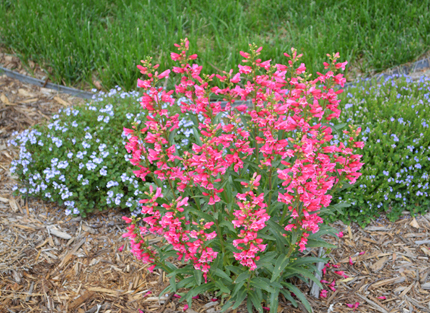
Coming from the Snapdragon family of flowering plants, penstemons provide a multitude of tubular flowers on their inflorescence that rise up above their various leaves. There are over 200 species of Penstemons. Their habits range from low growing ground cover types to taller ones that work in mixed border plantings or as showy specimen plants.
Although penstemons are usually short lived, around 3-4 years, many are easy to propagate from seed. Usually the life of the plants can be extended if you don’t overwater and if you dead-head the flowers after blooming.
Two species that I’ve grown from seed and that are quite striking in the garden are Penstemon barbatus, aka Scarlet Bugler Beardtongue, and Penstemon strictus, aka Rocky Mountain Penstemon. Penstemon barbatus has smaller gorgeous bright orange-red flowers, and Penstemon strictus has larger blue-purple colored flowers.
Definitely consider adding one of the beautiful and hardy penstemons to your water smart garden.
This is the official blog of Outdoor Design Group, Colorado Landscape Architects. For more information about our business and our services, click here.
Related Posts:







